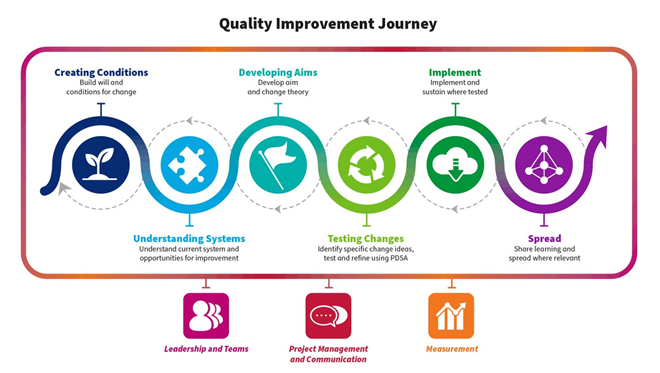It is recognised that not everyone working in health and social care has experience of using quality improvement (QI) methods.
Where this is the case for those involved in a care experience reflective improvement meeting, it is important to seek support from others in the team or from the wider organisation, such as qualified Improvement Advisors, to help robustly plan and take forward testing and implementation of change ideas.
The team can also develop their knowledge and pragmatic skills in using quality improvement approaches by utilising the online resources and personal development tools available at NHS Education for Scotland’s Quality Improvement Zone in ‘TURAS | Learn’.
The quality improvement journey
The Quality Improvement Journey shown in figure 5 illustrates the stages of an improvement initiative or project.
The Care Experience Improvement Model recommends using this approach to help develop a quality improvement infrastructure for the Reflective Improvement Meeting. It can help team members visualise how their work on gathering feedback can support them to ‘understand the current systems’ from the perspectives of people who receive care or support, their families or carers. This assists in moving care experience feedback into improvement action by using the last four stages of the model shown in figure 5 to guide the activities of the improvement team. Find out more about the quality improvement journey at the Quality Improvement Zone.

Feedback trends
Once the Care Experience Improvement Model is embedded into team practice and Reflective Improvement Meetings are established on a monthly cycle, the team may start to see trends in the data gathered from feedback over time. This can also at times result in less positive feedback re-emerging about changes the team thought were ‘quick wins’ early on. Seeing this in the data should be viewed as a positive aspect of the process now established, as it helps to provide assurance when changes are making a difference and enables the team pick up on any changes that may need to be reviewed by the team again.
Bringing these issues back to the reflective improvement team can be hard but it is important to focus on continuous improvement and maintaining the non-judgemental, non-defensive maxim of the improvement team.
Collaborative improvement partnerships
Once the Reflective Improvement Meeting is established the team should consider inviting people who use the service or those that support or advocate for these individuals to participate as improvement partners. The value of involving people who have a service user perspective in the improvement team can be immense as they can offer unique insights into what really matters and they can help focus the team’s attention on improvement ideas that are most meaningful for the people they care for or support.
